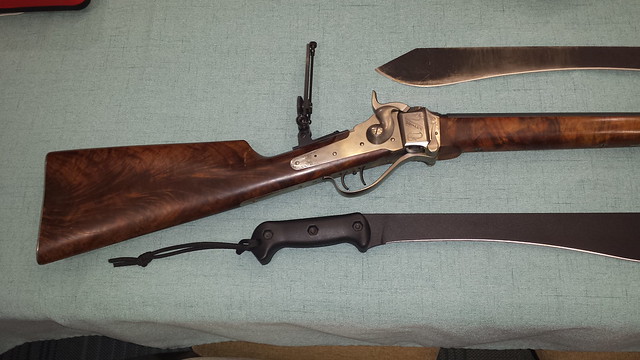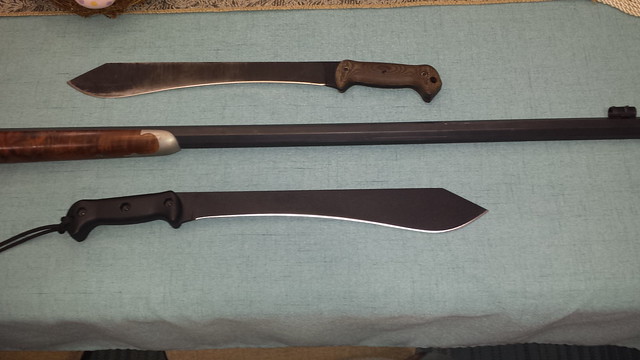Tanker 1/66,
I hear you on the eyes, age, iron sights deal. If you want to continue to mess with irons, especially on lever guns, here is what works for me.
First, fit a Lyman 17AHB front sight. (The HB is the shortest one, and is the one you want.) If you don't know how to file a front sight to fit (never file on the rifle!), then learn how or get a gunsmith to do it. It is not difficult once you learn a few tricks, but a sight pushing tool really helps (although I think I had to modify my tool to work with the Lyman 17A sights.)
The Lyman 17A is not much bigger than the front sight hood on most lever guns, so it doesn't look at all out of place. Stick with an aperture/ghost ring rear of your choice, but get something that can get high enough, because even the lowest Lyman 17A is a bit tall. The Skinner long/tall aperture holder or a Williams receiver sight works fine. (Edited to add: You may find the Skinner long/tall aperture holder to be too long and needing to be shortened a bit. But the regular aperture holder won't engage as many threads as you would like.) The first thing to try in the Lyman is one of the "lollipop with hole" inserts (inserts come with the sight.) You will discover that if you can see it, whatever "it" is, you can effectively aim at it. You will be back to aiming at 1" dots at 50 yards. I'm not exaggerating. It doesn't matter if your eyes are such that the front sight is a little blurry, because just like a rear ghost ring, you are looking through the front sight. Looking through the front sight instead of at it is a paradigm shift. You have to experience it to appreciate it.
Now that you are back to hitting stuff like you used to, you will discover the Lyman "lollipop with hole" insert blocks too many real targets. In other words, you can easily aim at that 1" dot, but it covers up way too much of a deer or something like that. You can aim at the deer, but you cannot tell exactly where on the deer you are aiming. The solution is to Google up Lee Shaver Gunsmithing and get a set of his inserts for the 17A. Use one of the ones I call "small circle suspended on cross hairs." I like the smallest one. Now, this insert might not be in focus for you either. Here is how I use it. The front sight will look like a "fuzzy dot", but one you can actually more or less see "through or around", I assume because there is a hole in middle and because the suspended circle has such a thin perimeter. On a big target, just aim with that fuzzy dot. On small targets, you will discover that when you are centered, you will clearly see the target just like you did with that obscuring Lyman insert. This is because you eye has a clear path to the target by looking through the rear ghost ring and through the unobstructed center of that "fuzzy dot."
I had great vision when I was younger. Was better than 20/20 in my right eye, maybe 20/15. Never needed glasses. My distance vision is still good, but I started needing drug store readers at about age 45. I'm almost 65 now and it is tough trying shoot a 10-shot group with my lever .22 off a bench at 50 yards aiming at a 1" dot. Why? Because usually before 10 shots the dot is so chewed up that my aiming point is all messed up!
Of course, nothing beats the single focal plane of a scope, and magnification always helps. But fitting scopes really well is almost impossible on some guns. Even if you manage to hang them on there, it is still "not quite right." The stock fit is wrong for a scope, hammers may get in the way, or the whole balance of the rifle is screwed up. Using what I describe above, I can use iron sights about as well as I ever could. I would bet on me now, to out shoot the younger me (having better vision) if the younger me were forced to use conventional open sights. The right iron sights make a huge difference. If you try this, I hope it works as well for you.
Another thing that works well when a scope is too big is the small red dots like the Bushnell TRS-25. People with a bit of astigmatism will not see a nice round dot, but a misshapen dot or a small "cluster." Having some astigmatism, that it what I see. No worries. Just consistently zero and aim with the highest "mini-dot" in the cluster!
-Gun Doc
P.S. The Lee Shaver inserts are a bit delicate. I like to take a Dremel to one of the Lyman inserts (usually one of the posts) and make a "protective washer with ears." Put the Shaver insert into the 17A, then the protective washer, then screw the locking ring on.
Edited to add: There are some sights that work well on well defined targets in good light, but are greatly compromised when trying to aim at real world targets in the field. The sights I describe above are meant for real world situations, but they but may not be the best for a specific, well defined, always the same target. And again, nothing much beats a scope for precise aiming, but that doesn't mean a scope is always the best choice.
I hear you on the eyes, age, iron sights deal. If you want to continue to mess with irons, especially on lever guns, here is what works for me.
First, fit a Lyman 17AHB front sight. (The HB is the shortest one, and is the one you want.) If you don't know how to file a front sight to fit (never file on the rifle!), then learn how or get a gunsmith to do it. It is not difficult once you learn a few tricks, but a sight pushing tool really helps (although I think I had to modify my tool to work with the Lyman 17A sights.)
The Lyman 17A is not much bigger than the front sight hood on most lever guns, so it doesn't look at all out of place. Stick with an aperture/ghost ring rear of your choice, but get something that can get high enough, because even the lowest Lyman 17A is a bit tall. The Skinner long/tall aperture holder or a Williams receiver sight works fine. (Edited to add: You may find the Skinner long/tall aperture holder to be too long and needing to be shortened a bit. But the regular aperture holder won't engage as many threads as you would like.) The first thing to try in the Lyman is one of the "lollipop with hole" inserts (inserts come with the sight.) You will discover that if you can see it, whatever "it" is, you can effectively aim at it. You will be back to aiming at 1" dots at 50 yards. I'm not exaggerating. It doesn't matter if your eyes are such that the front sight is a little blurry, because just like a rear ghost ring, you are looking through the front sight. Looking through the front sight instead of at it is a paradigm shift. You have to experience it to appreciate it.
Now that you are back to hitting stuff like you used to, you will discover the Lyman "lollipop with hole" insert blocks too many real targets. In other words, you can easily aim at that 1" dot, but it covers up way too much of a deer or something like that. You can aim at the deer, but you cannot tell exactly where on the deer you are aiming. The solution is to Google up Lee Shaver Gunsmithing and get a set of his inserts for the 17A. Use one of the ones I call "small circle suspended on cross hairs." I like the smallest one. Now, this insert might not be in focus for you either. Here is how I use it. The front sight will look like a "fuzzy dot", but one you can actually more or less see "through or around", I assume because there is a hole in middle and because the suspended circle has such a thin perimeter. On a big target, just aim with that fuzzy dot. On small targets, you will discover that when you are centered, you will clearly see the target just like you did with that obscuring Lyman insert. This is because you eye has a clear path to the target by looking through the rear ghost ring and through the unobstructed center of that "fuzzy dot."
I had great vision when I was younger. Was better than 20/20 in my right eye, maybe 20/15. Never needed glasses. My distance vision is still good, but I started needing drug store readers at about age 45. I'm almost 65 now and it is tough trying shoot a 10-shot group with my lever .22 off a bench at 50 yards aiming at a 1" dot. Why? Because usually before 10 shots the dot is so chewed up that my aiming point is all messed up!
Of course, nothing beats the single focal plane of a scope, and magnification always helps. But fitting scopes really well is almost impossible on some guns. Even if you manage to hang them on there, it is still "not quite right." The stock fit is wrong for a scope, hammers may get in the way, or the whole balance of the rifle is screwed up. Using what I describe above, I can use iron sights about as well as I ever could. I would bet on me now, to out shoot the younger me (having better vision) if the younger me were forced to use conventional open sights. The right iron sights make a huge difference. If you try this, I hope it works as well for you.
Another thing that works well when a scope is too big is the small red dots like the Bushnell TRS-25. People with a bit of astigmatism will not see a nice round dot, but a misshapen dot or a small "cluster." Having some astigmatism, that it what I see. No worries. Just consistently zero and aim with the highest "mini-dot" in the cluster!
-Gun Doc
P.S. The Lee Shaver inserts are a bit delicate. I like to take a Dremel to one of the Lyman inserts (usually one of the posts) and make a "protective washer with ears." Put the Shaver insert into the 17A, then the protective washer, then screw the locking ring on.
Edited to add: There are some sights that work well on well defined targets in good light, but are greatly compromised when trying to aim at real world targets in the field. The sights I describe above are meant for real world situations, but they but may not be the best for a specific, well defined, always the same target. And again, nothing much beats a scope for precise aiming, but that doesn't mean a scope is always the best choice.
Last edited:





